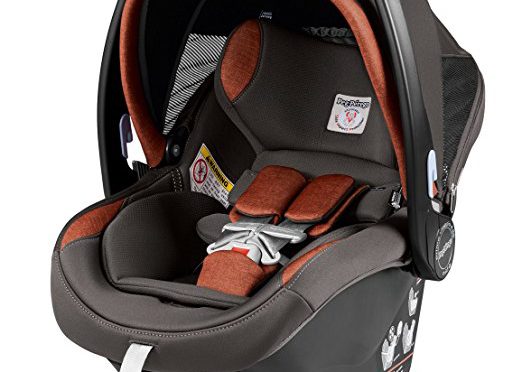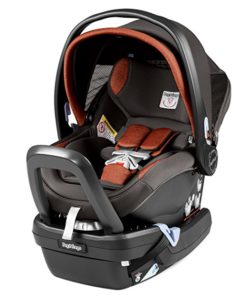
When it comes to car seats, safety starts with rear-facing. And while an infant seat won’t let you rear-face until 4 or 5 the way the best convertible car seats will (e.g., the Clek Fllo), a good infant seat will make the first several months of life with your baby a less stressful experience, even if only by letting you move your child from your vehicle to your home (or wherever you’re going) without waking him or her up. Today we’re going to look at an update of Peg Perego’s Peg Perego Primo Viaggio 4-35 car seat. I reviewed the Primo Viaggio infant seat years ago and found it a safe little seat with a luxury feel; let’s see how the updated version, the Peg Perego Primo Viaggio Nido, stands in comparison.
Peg Perego Primo Viaggio Nido – What’s the big deal?
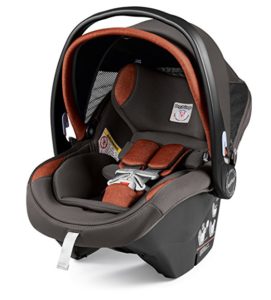 The Peg Perego Primo Viaggio Nido is an infant seat by Italian brand Peg Perego and the successor to their long-running Primo Viaggio 4-35 infant seat. It features a few unique elements that make it an update worth considering, most notably a load leg (a feature commonly found on European car seats but rare in US seats) to reduce downward rotation in frontal collisions as well as an oversized canopy to provide unparalleled levels of privacy and UV protection. The anti-rebound bar found in the original Primo Viaggio continues to be present.
The Peg Perego Primo Viaggio Nido is an infant seat by Italian brand Peg Perego and the successor to their long-running Primo Viaggio 4-35 infant seat. It features a few unique elements that make it an update worth considering, most notably a load leg (a feature commonly found on European car seats but rare in US seats) to reduce downward rotation in frontal collisions as well as an oversized canopy to provide unparalleled levels of privacy and UV protection. The anti-rebound bar found in the original Primo Viaggio continues to be present.
Being an infant seat, you can use it to take your newborn baby home from the hospital as soon as you’re allowed to leave; it has a minimum weight limit of 4 pounds and tops out at a generous 35 pounds, although, like virtually all infant seats on the market, it will be outgrown long before then by height. Slick and stylish, the Nido, which means Nest in Italian and Spanish, continues to be made in Italy and features additional goodies like a European belt path routing, a no-rethread harness, and 6 fabric patterns.
Peg Perego Primo Viaggio Nido Limits for Weight and Height
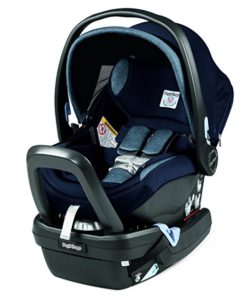 Rear-facing: 4 to 35 pounds. Best practices suggests rear-facing as long as possible, with ages 4 and 5 being common minimal guidelines. In the United States, that means rear-facing until 50 pounds (or the equivalent height limit in a 50-pound seat) if you can, since there’s no safer way for a child to travel in a passenger vehicle. You can rear face with a child up to 32″ in height and the shell height tops out at around 19″ without the inserts.
Rear-facing: 4 to 35 pounds. Best practices suggests rear-facing as long as possible, with ages 4 and 5 being common minimal guidelines. In the United States, that means rear-facing until 50 pounds (or the equivalent height limit in a 50-pound seat) if you can, since there’s no safer way for a child to travel in a passenger vehicle. You can rear face with a child up to 32″ in height and the shell height tops out at around 19″ without the inserts.
Because you won’t be able to reach 50 pounds in this or any infant seat, you’ll want to follow the Nido with a quality convertible seat that allows for extended rear-facing once your baby begins to outgrow it. Three good options include the Clek Fllo, the Clek Foonf, and the Diono Rainier; each will allow you to rear-face until 50 pounds, which is long enough to get virtually all children to 4 and most children to 5 or beyond.
Buy the Peg Perego Primo Viaggio Nido on Sale at Amazon here.
Dimensions and Key Features of the Peg Perego Primo Viaggio Nido
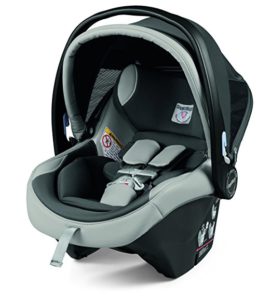 The Primo Viaggio Nido’s shell is 17″ wide at its widest point, which makes it a great infant seat for 3 across car seat installations, much like a set of 4 other narrow infant seats I frequently refer to parents. It weighs a rather hefty 11 pounds when both inserts are included (2 more pounds than the original 4-35) and has a 7 year lifespan for both the seat and the base; the expiration is based on the date of manufacture, which you can find on stickers attached to both the carrier and the base. As with most car seats, it has FAA approval, which you can find stamped on the side of the carrier; note that you can’t use the base on an airplane.
The Primo Viaggio Nido’s shell is 17″ wide at its widest point, which makes it a great infant seat for 3 across car seat installations, much like a set of 4 other narrow infant seats I frequently refer to parents. It weighs a rather hefty 11 pounds when both inserts are included (2 more pounds than the original 4-35) and has a 7 year lifespan for both the seat and the base; the expiration is based on the date of manufacture, which you can find on stickers attached to both the carrier and the base. As with most car seats, it has FAA approval, which you can find stamped on the side of the carrier; note that you can’t use the base on an airplane.
Using the Peg Perego Primo Viaggio Nido (Rear-facing installation and additional features)
Installing the Nido was pretty straightforward; it has the reputation of being a tricky seat to install in some cars, but between seat belt and LATCH options, you’ll likely be able to find an installation that works for you as long as you take your time.
Inserts: First of all, keep in mind that there are 2 inserts to deal with, just as with the original 4-35. The stage 1 insert is generally designed to be used from birth until 8 pounds, per the manual (review it for additional details and exceptions). Peg Perego does state that you can use the stage 1 insert as long as necessary if you have fit issues (e.g., if your baby weighs more than 8 pounds but there is still space between your baby’s torso and the crotch buckle). The Second stage insert is designed to be used above 8 pounds if needed.
Recline angle: Although the manual tells you that the angle you need will depend on your baby’s weight and to follow the indicator attached to the side of the base, Peg Perego will tell you that the recline bubble present is simply a guide, and that you should make sure your newborns have enough recline. What this means is that you should make sure your recline stays in the light blue section (i.e., the top third of the recline bar) for the first few months of life. If you need to use a pool noodle or rolled towel to get a good recline in your vehicle, Peg Perego gives you permission to do so whether or not you’re already using the recline foot. It’s unfortunate that this isn’t clearly explained in the manual.
LATCH installation: When installing with LATCH lower anchors, you’re unlikely to have any issues. You might note if you check the manual that you’re allowed to borrow lower anchors when your base is in the center vehicle seat; however, even though the manual doesn’t tell you this, you’ll still need to make sure this is okay with the manual of your vehicle, as a “no” in either manual will override a “yes” in the other.
Seat belt installation: A seat belt installation will also likely be straightforward; there are lock offs included in the base, and the instructions are easy to follow.
Baseless installation: A baseless installation is possible with the Nido, as it is with almost every infant seat. Although a base installation will be far faster and easier, especially for repeated installations, a baseless installation can be convenient when using taxis, Ubers, or other travel situations, or when you absolutely need to minimize installation space. You can install via either American or European belt routing. European belt routing has the advantage of also providing an equivalent method of preventing downward rotation (also achieved by the load leg or by rear-facing tethering, which is rarely available in US seats).
Load leg: The load leg is connected to the base; to use it, you simply squeeze a button attached to the leg and follow the instructions to lower it. You basically lower it until it touches the floor of the vehicle and click it into place. Keep in mind that in vehicles with raised or humped floors (e.g., a Subaru Outback, a Chevrolet Volt, and many others), you might not end up being able to use the load leg at all. That’s okay; it’s still a safe seat without it.
Why Buy the Peg Perego Primo Viaggio Nido?
In conclusion, despite its quirks, the Nido fulfills the basic needs of an infant car seat: it provides a safe way to transport newborns (full term or premature) out of the hospital and into a car, truck, SUV, or minivan, and keep him or her safe in such a vehicle for most of the first year of life. I’d like to see a simpler and more sensible recline guide and I wish the seat were lighter; 11 pounds is on the heavy end for an infant seat, although it’s worth remembering that many parents only carry infant seats around for the first few months before they start carrying their babies around instead in carriers. In the end, all infant seats become heavy with 12 pounds of baby in them, no matter how light the seats are to begin with. At any rate, the Nido is safe, stylish, and includes a pair of safety features–the anti-rebound bar and load leg–that are rare finds in American car seats. I like it and recommend it. Just remember it’s still important to rear-face once it’s outgrown.
You can buy the Peg Perego Primo Viaggio Nido in 6 colors here. It’s unfortunately not yet available in Canada, but Canadians can buy a similar seat, the Britax B-Safe 35, here.
 If you find my information on best practices in car and car seat safety helpful, you can do your shopping through this Amazon link. Canadians can shop here for Canadian purchases. Have a question or want to discuss best practices? Join us in the forums!
If you find my information on best practices in car and car seat safety helpful, you can do your shopping through this Amazon link. Canadians can shop here for Canadian purchases. Have a question or want to discuss best practices? Join us in the forums!

